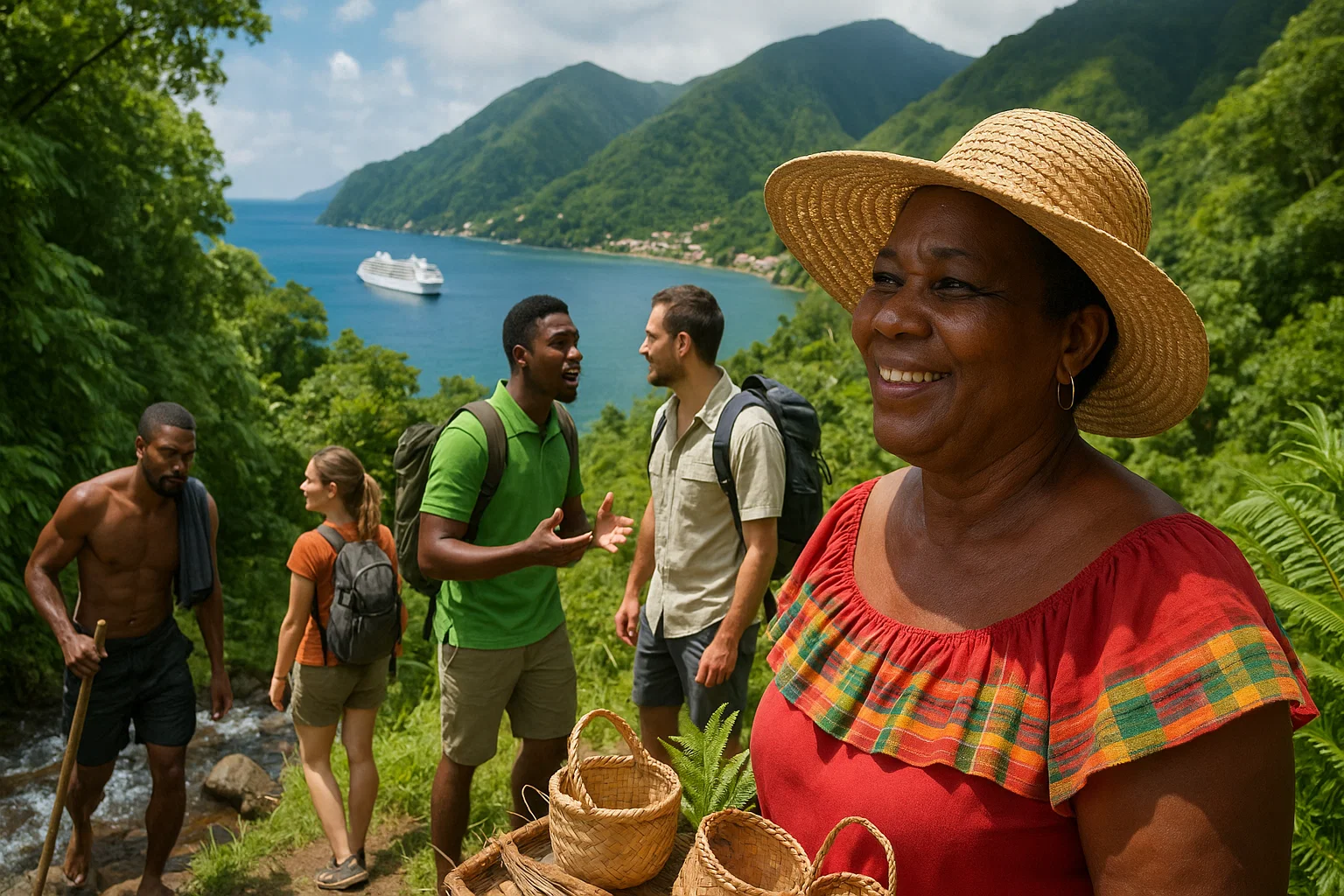Tourism Industry in Dominica

Dominica’s development has diversified, and the tourism industry has grown into a major source of revenue, jobs and cultural visibility, contributing significantly to opportunities available across its rural communities.
Dominica’s approach differs sharply from neighbouring territories that rely on large all-inclusive hotels or extensive beach-resort corridors. Instead, the country built an identity around volcanic landscapes, rainforest, biodiversity, freshwater features, hiking networks, marine ecosystems, and cultural authenticity. This nature-centred model attracts visitors who prefer sustainability, wellness, and adventure over mass-market recreation. Tourism’s growth reflects long-term structural changes, shifting global travel preferences, and investments that range from trail restoration to new hotel capacity and improved berthing facilities. Its long arc also reveals vulnerability to hurricanes and external shocks, making resilience a consistent theme in policy and planning.
Visitor Trends and Economic Contribution
Tourism’s economic influence deepened over several decades as Dominica adapted to changing conditions in agriculture and services. Income from international tourism increased substantially from the mid-1990s onward, rising from roughly US$42 million in 1995 to more than US$235 million in 2016. By the mid-2010s, tourism accounted for an estimated 30–36% of GDP when direct and indirect effects were combined. Employment in accommodation, guiding, food service, transport, cultural production, and small tourism-linked enterprises accounted for a significant portion of the national labour force. Visitor spending patterns consistently show that stay-over tourists generate the largest per-capita revenue, averaging EC$2,500–EC$3,500 per trip, compared with more modest single-day cruise expenditures.
Across arrival categories, long-term data show fluctuating performance shaped by airline connectivity, global economic trends and natural disasters. In 2016, Dominica recorded close to 356,000 total arrivals, with pre-hurricane stay-over arrivals generally ranging between 70,000 and 80,000 annually. In 2019, total arrivals were recorded at about 322,000, a slight reduction linked to regional flight adjustments. The COVID-19 pandemic produced a sharp decline in 2020, with arrivals falling to roughly 140,000, a drop of more than half. Recovery has been strong: 2023 saw nearly 400,000 visitors across all segments, marking the first year to surpass pre-pandemic totals. Early 2024 figures showed stay-over arrivals rising steadily, supported by improved airlift and increased accommodation options.
As tourism recovered, visitor spending strengthened. In 2019, expenditure was estimated between US$117.7 million and US$165.9 million, depending on the accounting method. Cruise arrivals have shown strong cyclical movement. Before Hurricane Maria, Dominica attracted well over 300,000 cruise passengers in peak years. The 2018–2019 season welcomed around 304,000 passengers, and the 2024–2025 season is projected to exceed 375,000 passengers from more than 230 cruise calls. Cruise visitors’ shorter spending windows limit per-capita expenditure, yet they generate significant revenue for taxi operators, craft vendors, tour companies, and waterfront businesses.
To give clarity to the long-term patterns, the following list summarises key statistical benchmarks across multiple decades:
Long-Term Visitor Statistics
- International tourism receipts grew from US$42 million in 1995 to US$235+ million by 2016.
- The tourism sector contributed 30–36% of GDP in the mid-2010s, including indirect impacts.
- Before major disruptions, stay-over arrivals averaged 70,000–80,000 annually.
- Total arrivals peaked at 356,000 in 2016, fell to 322,000 in 2019, declined to 140,000 in 2020, and rebounded close to 400,000 by 2023.
- Visitor expenditure estimates reached US$165.9 million in 2019, exceeding 80% of export earnings.
- Cruise arrivals frequently exceeded 300,000 passengers, with 375,000+ projected for 2024–2025.
- Yacht arrivals surpassed 8,500 movements in the first half of 2024.
These figures frame tourism’s central economic role and highlight the resilience needed to manage external shocks, and the industry’s capacity to rebound through targeted investment and community participation.
Sector Infrastructure and Market Segments
Tourism infrastructure spans air access, cruise berthing, marine facilities, accommodations, trails and protected natural areas. Airlift remains a defining factor in stay-over demand. Dominica’s current airports, Douglas-Charles Airport (DOM) and Canefield Airport (DCF), support regional turboprop operations but cannot accommodate large commercial jets. This limitation historically required multi-leg journeys through hubs such as Antigua, Barbados, St. Maarten, Puerto Rico, Guadeloupe or Martinique. These routes guided the growth of Dominica’s visitor profile, offering alternatives for travellers who choose immersive activities instead of familiar island vacations. Improvements in regional connectivity and the ongoing international airport project are central to the government’s strategies for expanding stay-over tourism.
Cruise infrastructure centres on the Roseau Cruise Ship Berth and Woodbridge Bay, supplemented by the Cabrits Cruise Ship Berth. Woodbridge Bay has a fuel pumping capacity of around 500 imperial gallons per minute and storage approaching one million gallons, while the Roseau berth delivers between 600 and 800 gallons per minute. These specifications support large vessels and strengthen Dominica’s appeal as a cruise stop. Seasonal variations and ship deployment decisions by cruise lines affect arrival volumes, but enhanced infrastructure ensures readiness for peak periods.
Marine tourism is anchored in Prince Rupert Bay, where the Portsmouth Association of Yacht Security
(PAYS) maintains moorings, provides security and organises guided experiences. The mooring field has expanded over time, with around 27-30 moorings currently in operation and plans for additional installations. Yachting is supported by multiple anchorages, roughly 15 across the island, attracting long-stay vessels and international sailing rallies. Marine biodiversity remains a core asset, with diving sites such as Dangleben’s Pinnacles, Champagne Reef and Scotts Head Drop-Off drawing divers from around the world. Dominica is one of the few places globally where sperm whales reside year-round, supporting whale watching businesses, scientific research and specialist eco-tourism.
Accommodation capacity has grown steadily, with an emphasis on small- and medium-scale eco-lodges, boutique inns, villas, and wellness retreats. Before Maria, room stock stood at roughly 1,100 rooms across more than 117 accommodation providers. New hotel construction in the 2020s, including luxury resorts financed through investment programs, is projected to add nearly 500 rooms by 2025, a 25% increase in national capacity. Many new properties incorporate sustainable architecture, climate-resilient materials and wellness programming consistent with Dominica’s nature-focused identity.
Natural attractions remain central to tourism. Dominica hosts one of the region’s most extensive networks of hiking trails, culminating in the 184-kilometre Waitukubuli National Trail (WNT). Waterfalls, lakes, rivers, features of volcanic origins and rainforest environments shape the visitor experience. Key attractions include Trafalgar Falls, Middleham Falls, Boiling Lake, Emerald Pool, Titou Gorge, Freshwater Lake and Cabrits National Park. Protected areas enforce environmental standards, visitor guidelines and monitoring schedules to maintain ecological health. Attraction restoration after Hurricane Maria focused on slope stabilisation, trail safety, boardwalk reconstruction and access improvements.
Tourism Assets and Infrastructure Snapshot
- Air Access: Douglas-Charles Airport and Canefield Airport; an international airport is under construction.
- Cruise Facilities: Roseau Cruise Ship Berth, Woodbridge Bay, and Cabrits Cruise Ship Berth.
- Marine Tourism: Prince Rupert Bay moorings, 15+ recognised anchorages, whale-watching corridors.
- Accommodation Stock: ~1,100 rooms pre-Maria; +500 projected by 2025.
- Major Natural Sites: Boiling Lake, Trafalgar Falls, Emerald Pool, Titou Gorge, Freshwater Lake.
- Hiking Network: 184 km Waitukubuli National Trail across 14 segments.
- Dive Sites: Danglebens Pinnacles, Champagne Reef, Scotts Head Drop-Off.
- Cultural Areas: Kalinago Territory, Grand Bay, Portsmouth heritage areas.
These assets shape niche market clusters, adventure tourism, marine ecotourism, wellness retreats, farm-to-table dining, and cultural experiences. Kalinago community programs, Creole traditions, music festivals and artisanal production reinforce the cultural dimension that differentiates Dominica’s tourism environment.
Future Growth and Development Outlook
Dominica’s long-term tourism outlook depends on new infrastructure, environmental stewardship, diversified product offerings and sustained investment in quality and resilience. The most anticipated development is the international airport, projected to begin operations later in the decade. Its long-term impact will be substantial: reducing multi-leg travel, enabling direct transcontinental flights and opening larger visitor markets. Policy discussions often reference the possibility of eventually reaching 500,000 stay-over visitors annually when paired with expanded room stock and improved transport networks. Achieving such growth will require careful management to preserve natural assets and maintain the country’s eco-focused identity.
Future cruise performance appears strong. With more than 235 calls and an estimated 375,000 passengers projected for the upcoming cruise season, Dominica is positioned to retain a healthy share of regional routes. Improvements to berths, boardwalks, pedestrian areas and vendor spaces aim to enhance visitor experience, while drainage upgrades, seawall reinforcement and ongoing dredging work together to reduce storm disruptions and allow larger vessels to dock safely.
Marine tourism is expected to grow through increased mooring capacity, improved anchoring alternatives and enhanced services for yacht crews. Conservation initiatives such as coral nurseries, coastal restoration and seagrass monitoring protect the ecological foundation on which marine tourism relies. Dominica’s year-round sperm whale population provides opportunities for scientific partnerships, conservation-focused travel and long-stay marine experiences.
Wellness and eco-tourism are positioned for growth, supported by volcanic features that offer geothermal spa potential, expanding retreats and forest-based meditation spaces, and a rising interest in culinary experiences as hotels embrace farm-to-table links with local agriculture. Digital marketing strategies highlight adventure, culture and nature themes, drawing repeat visitors and diaspora travellers.
Climate resilience remains a persistent consideration. Tourism infrastructure must withstand hurricanes, landslides and heavy rainfall. Investment in storm-resistant design, underground utilities in select zones, slope stabilisation and improved river defences form part of the island’s adaptation strategy. Community-based tourism programs promote decentralised growth, spreading economic benefits to rural villages and reducing pressure on major sites.
Dominica’s balanced tourism path, grounded in authenticity, environmental protection and gradual capacity building, positions the country to strengthen its global presence while maintaining the qualities that make it distinct. Continued collaboration between government, private operators, local communities and conservation groups will shape the next phase of the sector’s development.




